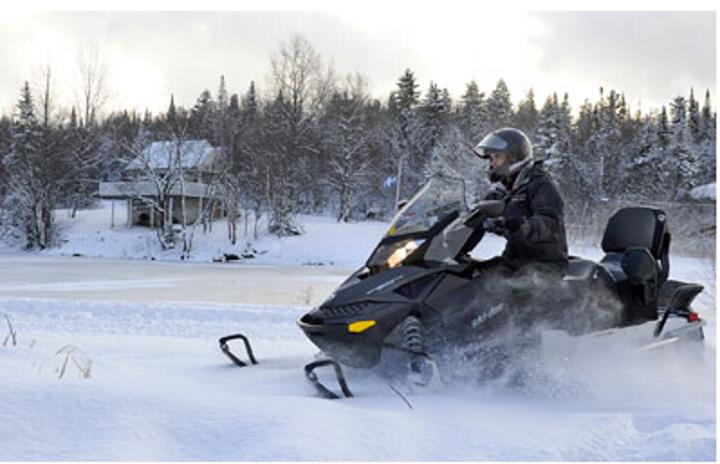In Maine, and nationwide, high speeds are a contributing factor to major accidents, authorities say
On a mild winter weekend with the classic January thaw in full swing last week, Maine snowmobile riders were not discouraged. They headed north to where the snow is ample and big riding takes place. And they were out in full force.
Southern Maine riders and non-residents travel to western Maine for the wide-open riding, the hospitality in the little towns, and the fact you can rip the engine wide open.
Some states have speed limits for snowmobiling — New Hampshire’s is 45 mph — but Maine does not. Maine game wardens say the laws in place are adequate to keep unsafe riders in check and riders say Maine’s trails are safe. Even so, wardens and conservation officers in other big snowmobile states say speed is a leading cause of snowmobile fatalities.

This year the Maine snowmobile season had a difficult start. One rider’s body was recovered in Rangeley Lake by Maine game wardens and three other riders who disappeared there are presumed dead, making it the first winter in 10 years where four snowmobile riders have died before the second week of January.
However, a look around New England and across the country shows a similar picture of a winter sport where reckless driving too often brings death to snowmobile trails.
In Maine, four to 12 people die annually in snowmobile accidents. In other snowmobile states, the number of fatalities is as high as 20 to 25.
"The three common threats are riding at night, speed and alcohol. That causes the majority of fatalities," said Mike Hammer, education coordinator for the Minnesota Department of Natural Resources.
The need for speed
But in the small towns of western Maine fast riding is a part of the big-woods landscape, Maine is the nation’s seventh-biggest snowmobile state, with registered sleds annually numbering between 60,000 and 100,000.
Last Saturday during a weekend when temperatures approached or lingered in the 50s, the tiny village of Oquossoc was crawling with sleds, trailers and helmet-clad riders stopping for lunch. Nearly 20 sleds were parked beside one restaurant.
On an old railroad bed that leads into Oquossoc, snowmobilers ripped it as fast as 80 mph. This is what riders come here for, said Jim Delaney of Boxford, Mass.

Delaney said the good trail conditions and freedom found on Maine’s trails are what draw him and his buddies. And Delaney, a snowmobiler for 40 years, doesn’t ride anywhere else.
"It’s the main reason I come here. I think it’s better than riding in New Hampshire, where the limit is 45," said Delaney, 47. "In New Hampshire, everyone is waiting to pass you. And they don’t like you to go by them. Here it goes pretty smooth. I’ve ridden 1,200 miles so far this year, all right in this area."
Delaney, who said he’s ridden the trails as fast as 87 mph, said a speed limit in Maine is unnecessary. He and his friends said the vast majority of riders are safe; and the trail conditions and signs make it easy to ride safe in Maine.
"This is safer than driving on the road, where people are texting and looking at their cellphone. I feel people here are better riders. Here, it’s more professional," said rider Scott Spence of Topsfield, Mass.
Along IT-84 West heading out of Oquossoc — a trail that runs all the way to New Brunswick — riders can fly as fast as 80 mph on their sleds.
But Ryan Harvey comes from Sanford with two friends most weekends and explained that the culture of snowmobiling in Maine, with dozens of snowmobile clubs teaching safe riding habits, makes riders feel safe here.
And the signs along Maine’s 14,000 miles of trails make the trail conditions clear. Signs even show riders how to signal to oncoming riders to indicate the size of their group. And virtually all riders do, Harvey said.
"On that one trail into town you can go 80 mph on that stretch," said Harvey, 33. "But it’s an old railroad bed. It’s 20-feet wide. And what’s a sled? Maybe 4-feet wide? I ride about 2,500 miles a year. I’ve ridden in New Hampshire plenty. You don’t feel safer there. About 99 percent of the riders here are doing what they should be doing."
Warden’s discretion
That may be true, but the problem is the ones who aren’t, said Cpl. John MacDonald of the Maine Warden Service.
"Often, speed does occur at night," said MacDonald. "And I think that is because riders need to operate within the limits of their headlights. It’s not as easy to see. It’s one of the common contributing factors."
Maine game wardens can issue a summons to a rider who drives a sled too fast for the conditions despite the lack of a speed limit, MacDonald said.
Wardens "can determine if they are operating to endanger," he said.
By comparison, all of New Hampshire’s 7,000 miles of trails are posted at 45 mph, and game wardens there can ticket them for going faster.
Elsewhere in New England, speed limits don’t exist outside of state lands except in Vermont, which posts speed limits of 35 mph on its trails and 50 mph across frozen lakes.
MacDonald said in some places in Maine — especially on the narrow woodland trails of southern Maine — even 35 mph would be too fast for the conditions. He said it’s more useful for game wardens to be able to charge either reckless operation or operating to endanger. A warden also can charge them with riding left of center.
Maine Game Wardens hand out on average 600 snowmobile citations a year, although MacDonald said the majority are for unregistered sleds, loud exhausts, operating on a public way or operating left of center.

The difficulty in curbing speed in Maine comes in the vast territory that needs to be patrolled.
New Hampshire has 7,000 miles of trails. Maine has twice that.
Still, in New Hampshire, where a statewide speed limit has been in place since 1981, fatalities occur, with as many as 11 a year.
Law enforcement officers there hand out anywhere from 200 to 400 speeding tickets each year, but it’s a tough problem to stop, said Capt. John Wimsatt of the New Hampshire Fish and Game Department.
"Alcohol and speed are the top two factors," Wimsatt said. "Speed enforcement definitely has had a positive influence. But it obviously varies when there is considerable snow. And the popularity of the sport has grown. And the quality of grooming has increased. The trails are smooth and fast."
Different states, same story
The story about speed is the same in the nation’s three biggest snowmobile states.
Annual snowmobile registrations top 200,000 each in Wisconsin, Michigan and Minnesota.
Conservation officers in the Midwest say a snowy start to winter tends to contribute to the excitement, high traffic and, in some cases, dangerous behavior on the trails.
In Wisconsin, which has around 225,000 registered riders, four snowmobilers also died on the trails in the first month of winter.
Wisconsin saw a rise in snowmobile deaths from 1976 to 2006 with a high of 39, but after a night speed limit was enacted in 2006, the number steadily decreased to around 10.
Michigan, which averages around 215,000 registered riders annually, has had more than 20 snowmobile fatalities a year.
There is no speed limit on Michigan trails, but, as in Maine, law enforcement officers can ticket fast riders.
"The (speed) law calls for ‘not greater than is reasonable on the existing conditions.’ What it comes down to is someone who is reckless and driving too fast for the conditions," said Conservation Officer Dean Molnar with the Michigan Department of Natural Resources.
And Minnesota, which averages 250,000 registered riders annually, has around 12 snowmobile fatalities each winter, and has had as many as 23, said Hammer.
"If we lose an inexperienced operator, it’s typically at night," Hammer said.
Nationally, snowmobile use has been on the rise, according to the International Snowmobile Manufacturers Association.
While it dropped to 1.4 million last year during a poor snow year, it mhas held at around 1.7 million the last decade, said Ed Klim, the association’s director.
And in Maine, as elsewhere in the country, officials here say there always will be a segment of the population who break the law, or simply act recklessly.
"As with cars or anything else, a certain small percentage are going to push the envelope in some way, with speed, or texting while driving or drinking while driving. It’s the same thing," said Bob Meyers, executive director of the Maine Snowmobile Association.


